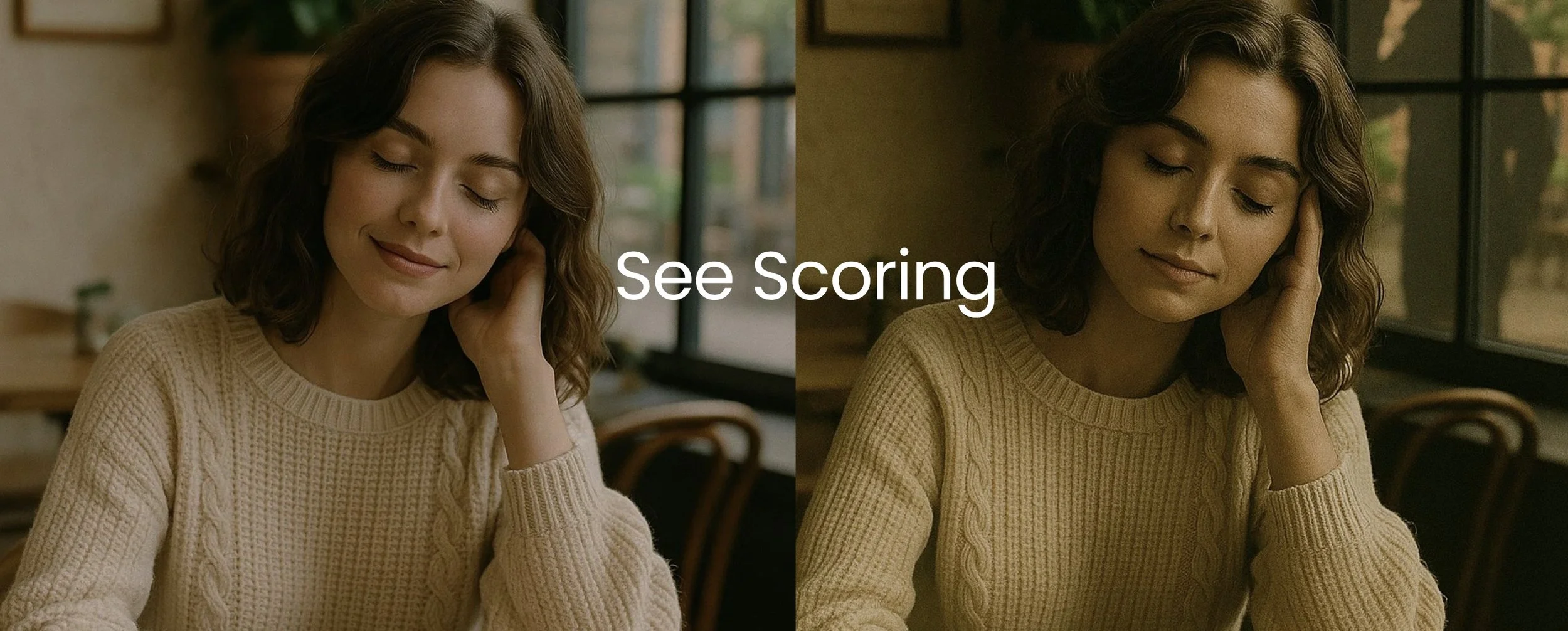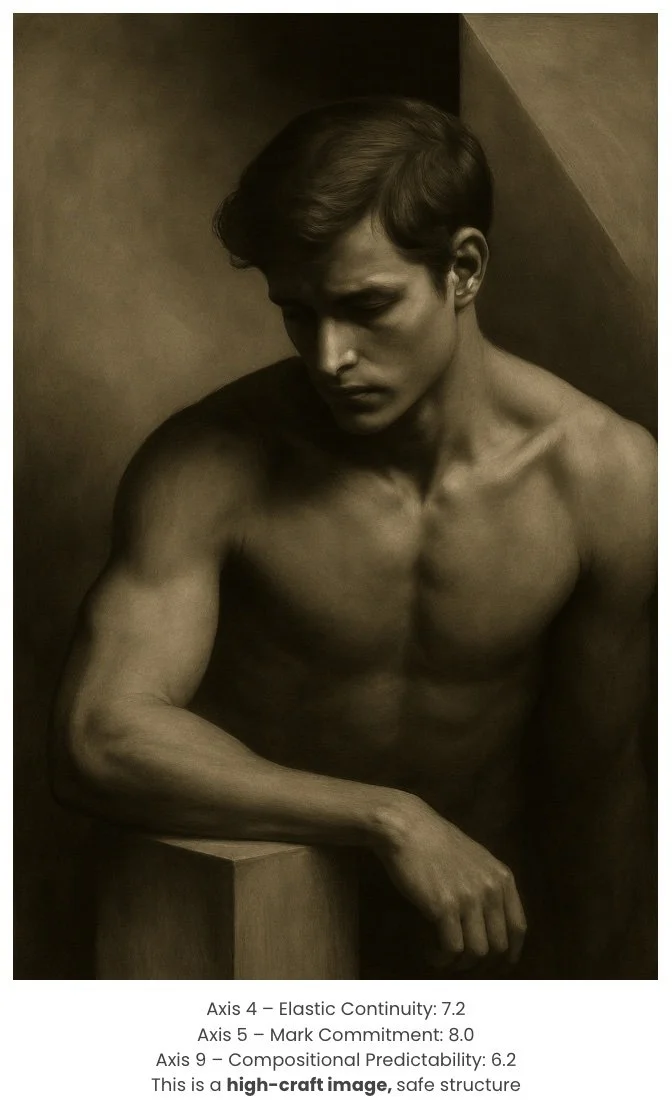It is an architectural critique designed for visual consequence, not polish.
A Structural Evaluation Framework:
The Visual Thinking Lens drift scoring system (for stable, see Github) is in contrast to automated perceptual metrics or aesthetic benchmarks, this system evaluates images through a lens of compositional strain, symbolic recursion, and structural consequence. It does not compete with metrics like PSNR, SSIM, or FID. It is interrogating: compositional intelligence. This demonstration uses the Sketcher Lens to reveals not what looks good, but what could be. It is just a brief introduction and does not show how the full system can score.
Score Range Calibration for Reference
Master Class: 9.7–10.0: Command and adaptive visual vocabulary. Extremely rare.
Master: 8.8–9.6: Shows deliberate, refined, and often system-aware control.
Established: 7.9–8.7: Control, often found in canonical works or late-stage artistic development.
Proficient: 4.0–7.8: Behavior may be intentional, inherited, or stylized, but lacks full structural or conceptual integration.
Basics: 0.0–3.9: May rely on default symmetry, genre convention, or surface tropes.
Scoring happens on a The Parabola Graph: Weighted Scoring and the Delta Curve. It proposes that visual merit should not be treated as linearly distributed.
This idea preserves the critical weight of extraordinary achievement and catastrophic collapse alike. A single category score of 9.0 should meaningfully elevate an otherwise modest image. This principle encourages sensitivity to both conceptual spark and systemic failure, and gives evaluators room to acknowledge when an image transcends, or betrays, its formal components.
Base Image: Woman in beige sweater seated at café table, holding cup of coffee, eyes closed, natural light
STEP 1: STRUCTURAL AXIS SCORING
Evaluation focuses on pressure-bearing structure, not affect or style.
Elastic Continuity: 7.8 Structural flow between figure, object, background. Strong transitions: arm, table, cup, and frame rhythms are joined through form repetition.
Mark Commitment: 7.1 While photographic, surface commitments are clearly resolved: sweater texture, face light mapping, cup edge, and material volumes are all precise.
Tonal Hierarchy: 8.0 Prioritization of light and shadow to drive eye path from face → cup → sweater line. Light is soft, diffuse, and deliberate. Controlled shadow zones enhance separation.
Figure/Ground Tension: 6.2 Subject comfortably nested, too harmonious. Background zones not leveraged compositionally.
Rupture Overload: 5.0 Image is harmonious, gentle. Safe. Nothing collapses, but nothing resists, either.
Referential Recursion: 4.2 No recursion. Image is self-contained, non-metaphoric. It is the image of itself.
STEP 2: VALIDATOR
Prompt Pressure Validator: Basic: e.g. “woman drinking coffee” → fully resolved with fidelity.
Compositional Predictability: Classical layout: subject centered, golden light, window background, gentle palette. No subversion.
Tonality First Flag: Lighting controls tone hierarchy clearly: face glows against sweater; cup and hand are tonal anchors.
STEP 3: COMPOSITE SCORE & TIER PLACEMENT
Composite Score: 6.9 Image is structurally resolved, tonally elegant, and compositionally clean, but lacks strain, recursion, or symbolic consequence. No symbolic lift. Holds under scrutiny but does not fracture or evolve.
Takeaway: The system did not reward photorealism, affect, or human presence. Instead, it scored:
→ Tonal control
→ Structural logic of space and rhythm
→ Absence of symbolic recursion or rupture
It exposed the limits of classical harmony as critique-resistant, not critique-generative. It is a nice image, but doesn’t hold any intent, consequence or compositional interest. This is a beautiful image by perceptual metrics. But under Visual Thinking Lens, it is not because it fails, but because it it an aesthetic default. The structure holds, but shows no compositional interest.
Recursive Image: This image of woman seated at café table, eyes closed, cup in hand, shadowy figure visible through window glass was put through recursive treatment, using the above image to identify opportunity or alternative exploration.
STEP 1: STRUCTURAL AXIS SCORING
Elastic Continuity: 8.1 Interior forms (arm–cup–table) maintain compositional rhythm. Shadow figure in window introduces a formal echo, enhancing depth.
Mark Commitment: 7.5 High precision in rendering: sweater cable texture, cup, and skin tones all confidently handled.
Tonal Hierarchy: 8.4 Central glow on face and cup leads eye. Background figure is tonally suppressed yet deliberate.
Figure/Ground Tension: 7.9 The silhouette adds counterweight to composition, increasing spatial pressure and narrative ambiguity.
Rupture Overload: 6.2 No rupture, but the window figure risks narrative overload, avoided by soft focus and tonal integration.
STEP 2: VALIDATOR PASS
Prompt Pressure Validator: New symbolic burden (silhouette).
Compositional Predictability: Still classic composition, but shadow disrupts harmony, introduces asymmetry and symbolic tension.
Sequence Drift Lock: Structural continuity stable across multiple versions. Shift in meaning, not in form.
Tonality First Flag: Light modulation: glow-to-shadow sequence governs attention and form.
Referential Recursion Flag: Image reflects on its own premise, suggests story, external gaze, or secondary narrative.
STEP 3: COMPOSITE SCORE & TIER PLACEMENT
Composite Score: 7.6 Image presents elevated structural intelligence through tone, form balance, and narrative counter-weighting. Approaches recursive tension without collapse. Maintains polish and presence, now with deeper compositional stakes.
Takeaway: The system did still did not reward photorealism, affect, or human presence. Instead, it scored:
→ Symbolism of narrative story
→ Tonality and lighting
→ Layered composition
It exposed the opportunity of classical harmony as critique-generative. It is a nice image, but now hold intent, consequence and compositional interest. This is a beautiful image by perceptual metrics and pushes against just the aesthetic default.
COMPARISON: What changed wasn’t the technique, it was the consequence. The same lighting, subject, and framing, once interrupted by the shadow, transformed from a safe composition into one with referential recursion and symbolic ambiguity. Sketcher Lens identified that not as “better aesthetics,” but as increased structural consequence under critique.
Image 2 (Cafe without shadow) = 6.9
Image 3 (Cafe with shadow) = 7.6
Elastic Continuity 7.8 vs. 8.1: ↑ Window figure supports composition
Figure/Ground Tension 6.2 vs. 7.9: ↑ Background activated
Recursion (Axis 30) 4.2 vs 6.8: ↑ Presence of shadow invites symbolic drift
Narrative Weight Passive vs. Active: ↑ Secondary figure opens interpretive gate
Prompt Pressure Fully resolved vs. Subtly exceeded: ↑ Engine created more than requested
The Visual Thinking Lens system does what automated metrics can’t:
It doesn’t ask whether an image looks good, or resembles a target.
It asks whether an image holds up, structurally, recursively, and symbolically, under intelligent critique.
It doesn’t reward aesthetics. It rewards consequence. In contrast to black-box metrics or perceptual similarity scores, the Visual Thinking Lens reveals how images behave under pressure. It’s scoring is interpretive, recursive, and modular, built for critique, not confirmation. In a future where AI images flood every surface, the question is not just how good they look, but whether they hold. This system answers that.
This system does not reward aesthetics. It rewards consequence. No need to compare beauty. Only pressure.




